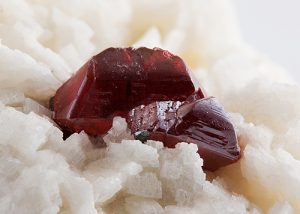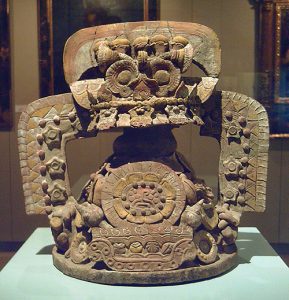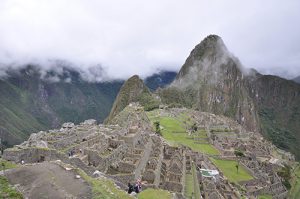
By Steve Voynick
The great pre-Columbian Native American civilizations—the Olmec, Maya, Inca, Aztec, and the gold-working cultures of Colombia—left behind as their material legacy a remarkable array of artifacts. Among them are magnificent pieces of gold work, figurines of silver and platinum, tools of copper and bronze, turquoise mosaics, jade masks, obsidian knives, bright-red pigments of cinnabar and hematite, intricate limestone and basalt carvings, and architectural monuments that still stand today.
The creative use of minerals in pre-Columbian times began with the Olmec fascination with jade. As the Americas’ first complex, advanced society, the Olmec preceded the Maya in Mesoamerica (the anthropological region of similar cultural traditions that extends from southern Mexico to Costa Rica). About 2000 BCE, Olmec sculptors began fashioning jade into beads, pendants, figurines, celts (ax heads), and realistic and stylistic human masks.
The term “jade” refers to gem forms of two different minerals, nephrite, and jadeite. Jadeite, or sodium aluminum silicate, is a member of the pyroxene group of inosilicates. With its greater hardness, more intensive colors, and subtle translucency, jadeite is the gemologically superior form of jade. All Mesoamerican jadeite came from the metamorphosed serpentinite rock of southern Guatemala’s Motagua River Valley.
Olmec Influencing Stone Use
Pure jadeite is white, but traces of various metals that replace aluminum within the crystal lattice create a range of pleasing colors, usually, but not always, some shade of green. With its closely packed crystal lattice and strong molecular bonding, jadeite’s hardness approaches that of quartz. Jadeite takes a fine polish, and its extraordinary toughness resists chipping and breaking. These qualities appealed to the Olmec, who developed a reverence for the stone. Jade represented breath, life, fertility, and power to the Olmec, as well as to the Maya and Aztecs who succeeded them.

The Olmec passed their jade-working skills on to the Maya, who fashioned large quantities of jade into anklets, wrist cuffs, mosaic masks, belts, earrings, figurines, ceremonial celts, and objects for funerary rituals and personal adornment. All were intricately worked and highly polished—an impressive feat, considering jadeite’s hardness. Mayan stoneworkers cut jade by repetitively pulling cords covered with silica paste through deepening grooves, then polished it by rubbing with a finer silica paste. As a major trading commodity, Mayan jade has been recovered from cultural sites far from Mesoamerica.
The arrival of the Spanish in 1521 disrupted all Mesoamerican cultures and ended the 3,500-year-old tradition of mining, working, and trading jade. Because the Spanish were interested only in gold, jade working became a lost art. The ancient Guatemalan jadeite mines were forgotten and have only recently been rediscovered.
If jade was the most widely used pre-Columbian gemstone, gold was the most widely worked metal. As early as 1000 BCE, forerunners of the Incas in what is now Peru systematically mined large quantities of gold from rich placer deposits. They simultaneously developed religions dedicated to gold and fashioned the metal into artwork to honor a god the color of gold itself—the sun. Driven by religious motivations, they advanced gold-working skills to the levels of both an art and a rudimentary science.
Sharing of Skills Across Civilizations
These skills spread north to Colombia, reaching Panama and Costa Rica by 200 CE, and southern Mexico by 900 CE. By then, pre-Columbian gold-working techniques were the world’s most advanced. Except for electroplating, they included all the fundamental techniques used by goldsmiths today. Gold working reached its technological and artistic peak about 1200 CE with the mountain cultures of what is now Colombia.
The craftsmanship vested in pre-Columbian gold work is remarkable, considering that it was achieved without iron implements or any modern metallurgical knowledge. With materials limited to drafted charcoal furnaces, stone tools, ceramics, wax, blowpipes, and natural chemical reagents, the gold workers’ most valuable resource was an uncanny understanding of the nature of gold itself.
Native gold always occurs combined with other metals that reduce its workability. To refine gold, goldsmiths mixed it with salt (sodium chloride) and heated it to incandescence. The salt combined with metal impurities to form chlorides, which were driven off as vapors, leaving behind gold of high purity.
Hammering with stone implements was a simple technique that took advantage of gold’s great malleability. Goldsmiths annealed or tempered gold by repetitively heating it, then cooling it in water. Repetitive annealing produced large, intact, smooth gold sheets of uniform thickness that could be fashioned into breastplates, funeral vestments, and masks.
Gold sheets were decorated with etched and repoussé designs, twisted and folded into various shapes, formed into hollow objects, or joined together with fused or stapled seams. Artistically perfect seams, created with heat and a chemical flux, were metallurgically identical to those made by modern gas welders.
Ancient Techniques Featured
In the lost-wax casting or ciré-perdue, process, goldsmiths made intricate carvings from palm-frond wax, enclosed them in clay, and fired them in charcoal ovens. This baked the clay and burned off the wax, leaving behind a hollow ceramic mold that was filled with molten gold and allowed to set. Removing the exterior mold revealed solid gold in the precise form of the original wax carving.

In Colombia and Panama, workers created tumbaga, a 2:1 copper gold-alloy with rich, reddish color and a convenient low melting point. Tumbaga, harder than either gold or copper, had excellent casting qualities. It was also easily gilded by a simple, chemical-heat process that removed the copper from the alloy surface to leave a bright, pure-gold exterior.
Pre-Columbian cultures considered gold a gift from their gods. Gold had no monetary value whatever and was used only for the finest art and most sacred religious expression. Incas and Aztecs used gold in religious ceremonies and to adorn temples. In Costa Rica, Panama, and northern Colombia, the gold work accompanied the dead into their graves for use in an afterlife. The mountain cultures of central Colombia sacrificed much of their gold work in the water of deep Andean lakes.
Pre-Columbian expertise in metallurgy extended well beyond gold. The highly mineralized altiplano region of Peru, Bolivia, and northern Chile gave pre-Inca cultures access to rich ores of gold, silver, copper, lead, tin, and mercury. By 2000 BCE, pre-Inca cultures had learned to smelt copper from sulfide ores in drafted furnaces. This process was later applied to the sulfide ores of silver, lead, and mercury, and the oxide ore of tin (cassiterite). By 1000 CE, pre-Columbian metallurgists were routinely creating tumbaga alloys and those of silver-gold, copper-tin (bronze), and copper-silver.
Artifacts Reveal Civilization Histories
The pre-Columbian concept of metals differed radically from that of Europe and Asia, where gold and silver were used primarily in monetary contexts, while utilitarian metals were made into tools, utensils, and weapons. Instead, pre-Columbian cultures used gold, silver, copper, and bronze for objects of religious worship or that represented social status. Only the Incas began making bronze tools, but not until 1200 CE.
By 800 BCE, pre-Columbian metalworkers were also mining and working platinum obtained from rich placer deposits near the present-day Ecuador-Colombia border. Anthropologists believe that platinum’s appeal may have been as a color substitute for then-rare silver. Because platinum melts at a temperature much higher than that of gold and which cannot be achieved in drafted charcoal furnaces, it is remarkable that platinum could be worked at all.
Although unable to melt platinum, pre-Columbian metallurgists nevertheless developed sintering techniques to create small ornaments of platinum or platinum-gold alloys. They hammered small platinum figurines from nuggets of sufficient size. More importantly, they made gold-platinum alloys by combining platinum placer particles with bits of gold, then repetitively heated and hammered the mix to form crude alloys with limited degrees of solid-state, metallic interdiffusion. Many pre-Columbian cultures used cinnabar, or mercury sulfide, which, in powdered form, is the red pigment vermilion. Systematic mining began about 1400 BCE at the great cinnabar deposit in Huancavelica, Peru. Many cultures used cinnabar to accent gold work, and as a pigment, cosmetic, and funerary adornment. Archeologists have found many Andean mummies completely covered in cinnabar.
Focused on Cinnabar
Cinnabar’s greatest use, however, was in the amalgamation process which combines mercury and gold into a sponge-like alloy that is easily separated by heating. Pre-Inca cultures were amalgamating fine particles of placer gold as early as 300 BCE, long before the process was known in Europe. Recent metallurgical analyses indicate that the gold in most pre-Inca and Inca gold work was recovered by amalgamation.
Amalgamation required large quantities of mercury, which was obtained by heating

——
INCENSE BURNER LID, at the Museum of the Americas in Madrid (Spain). Painted ceramic. Teotihuacan Culture, Xolalpán phase, Middle Classical Period (400-700 CE). Central Mexico.
cinnabar ore. In this simple form of smelting, oxygen, and sulfur combined to form sulfur dioxide, while mercury vaporized and was recovered as condensate in ceramic retorts.
Archaeologists have only recently recognized how extensively amalgamation was employed among pre-Columbian Andean cultures. They now agree that the huge quantities of Incan gold could only have been recovered by amalgamation. Unfortunately, the material record of pre-Columbian cinnabar smelting and amalgamation was obscured by later Spanish mining and smelting operations. The Maya considered cinnabar sacred. They probably obtained it from deposits in Honduras and used it to accent jade carvings, as a pigment for ceremonial pottery, and in burial rituals. Skeletal remains excavated from Mayan tombs are often covered with bright-red cinnabar.
One of the most precious pre-Columbian mineral commodities, certainly by modern standards, was emerald, the green gem variety of beryl, or beryllium aluminum silicate, which was mined at Muzo, Cosquez, La Pita, Chivor, and Itaca in central Colombia. The Muzo culture began systematically mining emeralds about 1000 CE for trade and adornment of royalty.
Conquests Mark Pre-Columbian State
The Spanish conquests revealed the extent of the pre-Columbian emerald trade and the extraordinary quality of the gemstones. When the conquistador Hernán Cortéz met the Aztecs in Mexico in 1519, the ruler Montezuma was bedecked in large, fine emeralds. So, too, was the Inca ruler Atahuallpa when Francisco Pizarro arrived in Peru in 1533. According to Spanish documents, Pizarro’s spoils included four chests of emeralds.
Turquoise is also found in Mesoamerican cultural sites. Aztec tombs have yielded elaborate mosaics and masks made of thousands of pieces of inlaid turquoise. Given the absence of known Mesoamerican turquoise sources, archaeologists initially believed that all this turquoise came from the American Southwest. But recent geochemical analyses of Aztec turquoise indicate that most were probably mined in Mesoamerica from deposits that were either mined out or have not yet been rediscovered.
Although all pre-Columbian cultures used various forms of microcrystalline quartz extensively, the premier stone-flaking material was obsidian. Obsidian, an extrusive igneous rock, forms from the very rapid solidification of rhyolitic (silica-rich) lava and consists primarily of silica. Because of its amorphous or noncrystalline structure, it is classified as a mineraloid, a mineral-like material that does not meet the definition of a mineral.
With its pronounced conchoidal fracture, obsidian flakes readily into points and edges far sharper than those of quartz. The Aztecs knew obsidian as teoteti (“divine stone”) and used it for tools, weapons, mirrors, mosaic inlays, and ceremonial knives. They believed that Tezcatlipoca, their god of sorcery and divination, lived within obsidian and revealed his image in reflections from its glassy surface. In Aztec legend, Itzcoliuhqui, the god of the curved obsidian blade, blinded and cast down from the heavens, sought revenge by slashing random victims with obsidian blades.
Architecture and Artifacts

Aztecs used obsidian knives in human sacrifices intended to give the sun the “strength” to replace the night. Only obsidian blades could remove human hearts quickly enough to be lifted to the sun while still pulsating. The Aztecs also practiced self-mutilation with obsidian blades, ritualistically cutting their tongues and ears, then flinging the blood high in offerings to the sun.
The Aztecs placed great value on highly polished obsidian mirrors, which were among the objects collected by the conquistadores. Europeans were intrigued by the spiritual aspects of these obsidian mirrors. Dr. John Dee, an English occultist and consultant to Queen Elizabeth I, used an Aztec mirror to divine his queen’s future. Among the most celebrated of all Elizabethan artifacts, John Dee’s obsidian mirror, carved by the Aztecs, is displayed at the British Museum in London.
The deadliest Aztec use of obsidian was the macuahuitl. This four-to-five-foot-long, broadsword-shaped piece of wood had a two-handed grip and grooved edges set with pieces of flaked obsidian. Spaniards described the macuahuitl as “sharper than a blade of Toledo steel” and capable of severing the head and legs of horses.
The Inca, Maya, and Aztecs are known for their monumental architecture, which utilized local stone materials and was designed following cosmological, astronomical, and religious concepts. Inca architecture, best represented by Peru’s Machu Picchu ruins, is built of limestone, diorite, and black andesite blocks that were worked with bronze and stone tools, sometimes so precisely that mortar was not necessary for construction.
Aztec architecture, exemplified by the Templo Mayor at Tenochtitlán, Mexico, included organized cities, stepped pyramids, and temples, most built of the porous, lightweight volcanic stone tezontle, reddish–to-purple-brown andesite that was cut by abrasion with cords and silica paste. Mayan architecture, such as the pyramids and temples at Chichén Itzá, are built of blocks of limestone, a sedimentary rock consisting primarily of calcite (calcium carbonate).
The Maya also made mortar from limestone. Roasting (calcining) the limestone in fires converted the contained calcite to lime (calcium oxide). The lime was then concentrated and mixed with water to create a slaked-lime (calcium hydroxide) mortar which, when applied to limestone blocks, recrystallized as a durable, bright-white, concrete-like material. The Maya and the later Aztecs used highly refined lime to make stucco, a fine-grained, white plaster for use as an exterior architectural finish and a mural substrate.
Limestone served as a sculpting medium for stelae, tall, elaborately carved, bas-relief stone pillars that commemorated important events in Mayan life. The engraved hieroglyphs of the written Maya language completely covered many stelae.
Perhaps the greatest single example of pre-Columbian stone carving is the monolithic Aztec sunstone, or “calendar stone.” This 21-ton, 12-foot-diameter, 3-foot-thick piece of solid basalt, now displayed at Mexico City’s National Anthropology Museum, is deeply and intricately engraved with symbols of religious, astronomical, and chronological significance. All pre-Columbian civilizations manufactured ceramic pottery, storage vessels, funerary urns, beads, figurines, incense burners, and ceremonial objects. The skills needed to shape and fire clay into hard, durable ceramic objects evolved more than 8,000 years ago.
Clay is a general term for fine-grained earth consisting mainly of tiny particles of hydrous aluminosilicates of sodium, potassium, calcium, and magnesium. These clay particles, which have sheet structures and perfect cleavage, occur in surface sediments derived from the weathering of feldspar-group minerals. The most abundant clay minerals are kaolinite and montmorillonite.
Wet clay has a plastic consistency and is easily moldable. Pre-Columbian potters purified clay by drying, grinding, and screening, then added various tempering materials to prevent shrinkage and cracking during firing. After firing, the wet, molded clay had dried, lost its plasticity, and hardened into permanent shapes.
Pre-Columbian polychrome pottery had four basic colors—off-white, reddish-orange, brownish-yellow, and black. The off-white is the color of the refined clay itself. The other colors were produced by glazes containing the only three common mineral pigments that could survive the firing process. Hematite, or iron oxide, produced red to reddish-orange colors. Brownish-yellows came from limonite, a mix of iron oxides and hydroxides, mainly goethite, or basic iron oxide. Blacks were often produced by glazes of pyrolusite or manganese oxide.
The Maya were especially adept at preparing red hematite pigments. They prepared red pigments with great brilliance and color saturation by grinding refined hematite to a flour-like fineness. The most striking examples of Mayan red pigments are in the 10-foot-tall murals at the Bonampak archaeological site in Chiapas, Mexico. The Bonampak murals, which depict various aspects of Mayan life, are a kaleidoscope of saturated blacks and vivid reds, accented by orange, yellow, and blue colors, the latter created by organic pigments. Gold and jade are the materials most closely associated with the pre-Columbian civilizations of the Americas—the Olmec, Maya, Incas, Aztecs, and the gold-working cultures of Colombia. But these great cultures also mined and utilized a much wider array of minerals, the creative use of is readily apparent in their remarkable artifacts.














